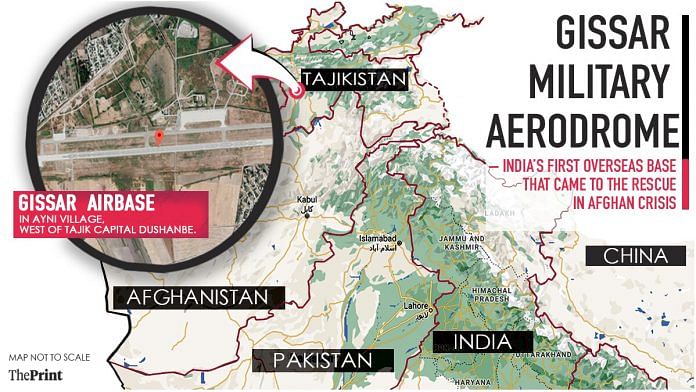SNEHESH ALEX PHILIP

New Delhi: Gissar Military Aerodrome (GMA), India’s first overseas base operated along with Tajikistan and aimed at giving a strategic heft to their military operations and training, has come in handy in India’s effort to evacuate hundreds of its citizens and Afghans from Kabul, overrun by the Taliban since last Sunday.
The GMA, popularly known as the Ayni airbase named after the village Ayni, is just west of the Tajik capital Dushanbe. It has been administered by India along with Tajikistan for nearly two decades, sources in the defence and security establishment told ThePrint.
National Security Advisor Ajit Doval and former Air Force chief Air Chief Marshal B.S. Dhanoa had a key role in setting up the base, which was funded by the Ministry of External Affairs, sources said.
Though outside the public eye, the base has come under the spotlight because of the ongoing evacuation process from Afghanistan during which C-17 and C-130 J transport aircraft of the Indian Air Force besides an Air India aircraft have used the Tajikistan airbase, reported ANI.
A C-130 J aircraft, for instance, airlifted 87 Indians from Kabul and landed in Tajikistan. The evacuees were eventually picked up by an Air India flight that took off from the Ayni airbase and brought back to India.
Similarly, when India evacuated its embassy staff from Kabul along with stranded Indians on August 17, the C 17 was waiting at the GMA for clearance from the Americans to fly in and evacuate them. This was because the aircraft could not remain at the Kabul airport since it would have taken up the already scarce place on the tarmac, sources said.
GMA project began in 2002
The GMA is often confused with another Farkhor base. Farkhor in southern Tajikistan — near the border with northern Afghanistan — is a city where India ran a hospital in the 1990s.
It is at the same hospital that the powerful Afghan Tajik guerrilla leader, the late Ahmed Shah Masood of the Northern Alliance — which fought the Soviets and later the Taliban — was brought in for treatment after a suicide bomber blew himself up near him in 2001. However, the military doctors at the hospital could not save him despite all efforts.
Following the 9/11 strikes, the hospital ceased operations, sources said. India runs a still functional 50-bed hospital for Tajik military personnel at Qurgan Teppa in southern Tajikistan.
It was around 2001-2002 that “radical thinkers” in the MEA and security establishment came up with the idea of developing the dilapidated GMA in Ayni, a project which was strongly backed by former defence minister the late George Fernandes, sources said.
The IAF appointed then Group Captain Naseem Akhtar (Retd) to begin the work on the airbase. Akhtar, who retired as Air Commodore, was followed by another officer during whose tenure the private contractor engaged by the Indian government went back on his obligations which then led to a legal suit.
The Indian government also roped in the Border Roads Organisation (BRO) team which was led by a Brigadier. At that point in time, there were around 200 Indians working on the project and the airstrip at Gissar was extended to 3,200 metres — long enough for most fixed-wing aircraft to land and take-off.
Besides this, the Indian team also developed hangars, overhauling and the refuelling capacity of aircraft. It is estimated that India spent close to USD 100 million developing the GMA.
Air Chief Marshal Dhanoa was appointed the first Base Commander of an ‘operational’ GMA around the end of 2005 when he was a Group Captain.
However, it was only under the Narendra Modi government that India undertook the first international deployment of fighters — Su 30MKI — to the GMA on a temporary basis, sources said.
The strategic idea behind the GMA
Sources said that the GMA gives a lot of strategic heft to the Indian military. Tajikistan shares borders with China and Pakistan. It adjoins Afghanistan’s Wakhan Corridor, a narrow strip of land that shares a boundary with PoK and China.
With Tajikistan just about 20 km from Pakistan-occupied Kashmir across the corridor, having the ability to operate from Tajikistan gives a lot of options to military planners.
IAF fighters can target Peshawar from Tajikistan, which puts additional pressure on the resources of Pakistan, sources said.
At a time of war, this means that Pakistan will have to move its assets from its Eastern borders to the Western which weakens its direct front with India.
Another big advantage of having a foothold in Tajikistan is that it opens up different routes into Afghanistan, bypassing Pakistan.
However, some within the defence and security establishment, argue that India has never been able to fully utilise the GMA or the investments made. Other such joint collaborative efforts with other countries, too, have not fully taken off over the years, they said.
No comments:
Post a Comment